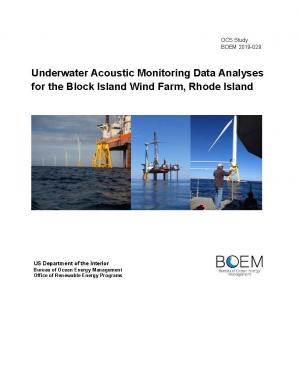Key Researchers: Jennifer L. Amaral, Adam S. Frankel, Anwar A. Khan, Ying-Tsong Lin, James H. Miller, Arthur E. Newhall, Gopu R. Potty, Kathleen J. Vigness-Raposa
The installation of foundations of the Block Island Wind Farm, 2.8 miles southeast of Block Island, Rhode Island, was completed in October 2015. The installation included the driving of segmented piles at each of the four corners of the jacket foundations. For most piles, three segments were driven. Pile driving produces intense sound that will affect marine life. During some of the pile driving events, sound was measured using a towed array as well as a sled with hydrophones configured to measure particle acceleration. Particle acceleration potentially can impact fish and invertebrates. The data collected during pile driving was evaluated using three-dimensional sound propagation modeling.
Findings
Underwater pile driving sound was above background sound levels at ranges in excess of 20 km (12.4 mi) and that the received levels were approximately 120 decibels
Sound levels were also shown to be dependent upon the orientation of the pile to the recording sensor
Particle acceleration levels (pressure from the sound) in water are slightly above the behavioral sensitivity in the frequency range 30 to 300 Hertz and suggest that some fish may barely ‘detect’ the particle motion during construction at 500 m range.
How BOEM will use this information
Evaluate impacts on marine life from sound generated during pile driving
Identify mitigation measures to reduce the impacts from sound


